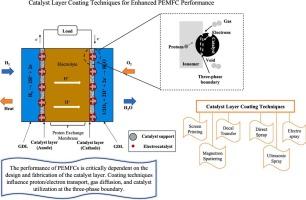聚合物电解质膜燃料电池性能催化剂层涂层技术研究进展
IF 5.9
3区 工程技术
Q1 CHEMISTRY, MULTIDISCIPLINARY
Journal of Industrial and Engineering Chemistry
Pub Date : 2025-05-21
DOI:10.1016/j.jiec.2025.05.041
引用次数: 0
摘要
催化剂层的纳米结构工程是聚合物电解质膜燃料电池(pemfc)膜电极组件(MEAs)制造的一项基础技术。首先,简要阐述了pemfc中MEAs的设计和工作原理。具体来说,在文献中进一步解释了多孔介质、膜和催化剂层(CL),以了解mea的主要功能。本文介绍和总结了CL涂层技术的进展和发展,重点介绍了它们对传输性能和整体电池性能的影响。质子、电子、试剂和产物的输运很大程度上受CLs制备过程中所采用的工艺参数的影响。这项工作旨在通过评估各种用于pemfc替代电源的涂层技术来促进工艺选择。最后,本文强调了未来的进展将通过理解涂层技术如何发展来应对挑战,以及如何通过制造CL进一步发展以达到高PEMFC性能,从而为商业化铺平道路。这项工作的结果表明,在CL涂层过程中,催化剂油墨的分散,铂(Pt)的使用和催化剂颗粒的团聚必须仔细解决。这些发现可用于学术和工业研究人员,以确保电极制造的高质量控制。本文章由计算机程序翻译,如有差异,请以英文原文为准。

Progress of catalyst layer coating techniques for polymer electrolyte membrane fuel cell performance: A review
The nanostructure-engineering of catalyst layers signifies a fundamental technology in the fabrication of membrane electrode assemblies (MEAs) for polymer electrolyte membrane fuel cells (PEMFCs). Firstly, the design and working principles of MEAs for PEMFCs are elaborated briefly. Specifically, the porous media, membrane, and catalyst layer (CL) are further explained in the literature to understand the principal functions of MEAs. This review paper describes and summarizes the progress and developments of CL coating techniques, with an emphasis on their impact on transport properties and overall cell performance. The transport of protons, electrons, reagents, and products is heavily influenced by the process parameters adopted during the preparation of CLs. This work aims to facilitate process selection through evaluation of a variety of coating techniques for alternative power sources of PEMFCs. Lastly, this paper highlights that future progress will be facilitated by an understanding of how coating techniques have evolved in response to challenges and how they can be further developed to reach high PEMFC performance through fabrication CL to pave way for commercialization. The results of this work demonstrate that during the CL coating process, catalyst ink dispersion, platinum (Pt) usage, and agglomeration of catalyst particles must be carefully addressed. These findings can be useful for both academic and industrial researchers to ensure high-quality control in electrode fabrication.
求助全文
通过发布文献求助,成功后即可免费获取论文全文。
去求助
来源期刊
CiteScore
10.40
自引率
6.60%
发文量
639
审稿时长
29 days
期刊介绍:
Journal of Industrial and Engineering Chemistry is published monthly in English by the Korean Society of Industrial and Engineering Chemistry. JIEC brings together multidisciplinary interests in one journal and is to disseminate information on all aspects of research and development in industrial and engineering chemistry. Contributions in the form of research articles, short communications, notes and reviews are considered for publication. The editors welcome original contributions that have not been and are not to be published elsewhere. Instruction to authors and a manuscript submissions form are printed at the end of each issue. Bulk reprints of individual articles can be ordered. This publication is partially supported by Korea Research Foundation and the Korean Federation of Science and Technology Societies.

 求助内容:
求助内容: 应助结果提醒方式:
应助结果提醒方式:


